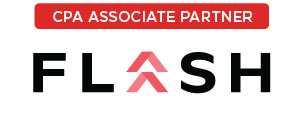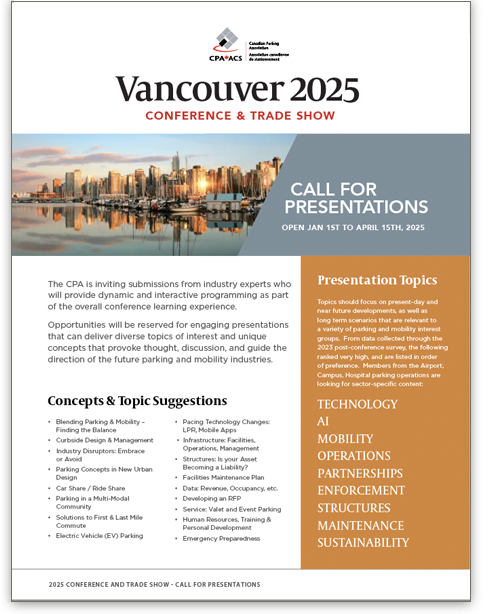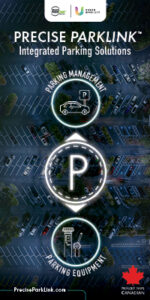By Patricia Kierans, MA Candidate in Critical Disability Studies, York University
We have all seen cars cruising around and around parking lots, looking for the ‘sweet spot’ parking space that will get them closest to their destination. And for accessible parking spots, this pressure is only magnified. The Ontario Building Code (OBC) only requires a minimum of one accessible parking space per every one hundred1. With the number of people with disabilities, and accessibility parking permits, increasing every year, how will parking lot owners rise to the challenge of increased demand for accessible parking?
The percentage of people with disabilities in Canada is increasing at a faster rate than the growth of the general population. Today, approximately 14% of Canadians have a disability that impacts their daily activities, with 80% of those report use of an accessibility aid2. In 2011, Human Resources and Skills Development Canada predicted the annual population growth from 2006 through 2036 would be ~1.3% per year, but the number of people with disabilities will increase by ~2.5% per year3.
The exact concentration of people with disabilities impacting mobility varies greatly across the country. People with disabilities, when possible, migrate toward urban areas seeking better access to specialized medical care, social services, and accessible public transit and buildings. Consequently, urban regions are predicting a major increase in the percentage of people with disabilities. The Peel Region of Ontario, including Brampton, has predicted a general population increase of 38% between 2001 and 2021, but an increase of 75% in the number of people with disabilities4.
While each province within Canada has differing requirements for the percentage of accessible parking spaces required for any parking facility, the ratio of accessible parking spots to regular spots remains extremely low. While all parking lots in Ontario adhere to the OBC’s minimum 1 space per…
By Chelsea Webster & Richard Simpson, ParkPlus System
Procurement
Many in sales might suggest this should be considered a four letter word. Having experienced two sides of this process, I know it can be a great tool and it can be a disaster, for any group involved. My experience is that everyone involved in the development of an RFP has the best of intentions to provide the best value or benefit to the organization.
Fundamentally issues are often created right from the beginning. Depending on your perception you will measure value or benefit in different ways. How is the organization structured? Does it have supply chain management, strategic sourcing and/or procurement departments? How do these departments integrate with the needs of their internal clients, i.e. other departments? How are they measured and compensated?
Do you get what you pay for? I’m not suggesting you have to pay the most to get the best. If you’re buying a widget or commodity item then price might be the best measurement. However when it comes to services or more intangible purchases it becomes very hard to measure. RFPs that are well designed and thoughtfully put together end up being far more constructive for the organization trying to measure what the market is offering and will likely yield better quality responses for review.
As a salesperson, there have been many RFPs that I haven’t responded to purely because the initial document showed the process would be arduous and painful to go through. Ironically it is often the same for the employees trying to manage the process internally, or it is really easy because they have so few responses to review. Does this bring the best value or benefit to the organization? Alternatively, I think we can all agree that sometimes the RFP process is merely for optics, to…
What does the parking industry allocate as an average spend for Audit/Loss Prevention as a percentage of gross revenue?
CBC Alberta @ Noon | Wednesday, April 12
Episode: we ask for your thoughts about parking enforcement; and we talk about the future of electric cars.
Link to: http://podcast.cbc.ca/mp3/podcasts/calgwildrose_20170412_29235.mp3
CBC News Edmonton AM | April 12, 2017
CBC’s Mark Connolly interviews Liz Wolfson, CFO for Clancy Systems International, Inc. and Carole Whitehorne, Executive Director, Canadian Parking Association.
A Commemorative $10 Bank Note
Today, the Bank of Canada unveiled a commemorative $10 bank note to celebrate Canada’s 150th anniversary of Confederation.
The Canada 150 bank note celebrates Confederation with a unique design depicting our history, our culture and our land. This commemorative note will be available to Canadians through their financial institutions starting in June and will circulate along with the existing $10 note.
This commemorative note has some new security features and others that are the same as the current Polymer series notes. These features make the note easy to check and difficult to counterfeit.
Visit the Bank’s website for educational tools to help you recognize this historic addition to Canada’s polymer notes.
Produced in limited quantity, commemorative notes are designed to mark historic milestones. Since this commemorative note will be issued in relatively small numbers and may be retained by Canadians, its volume and time in circulation may be limited.
Retailers should contact their equipment supplier or manufacturer with any questions about machine compatibility.
Please don’t hesitate to contact me if you have any questions.
Cliquez ici pour visualiser l’information en français.
By Giovani Forner, Director of Research and Development
Brazil is widely known for its amazing natural beauties and top soccer players, but now a group of engineers from Porto Alegre wants to place the country as a leader also in the automated parking field. Pioneers in providing innovative products, Engeltec developed a new, complete solution for Valet Parking that is shaking the national market, and now they prepare to cross borders, starting with Canada.
Living in a country similar to Canada with continental dimensions, Brazilians love their cars, even though they have to pay among the highest prices in the world to drive them (due, in large part, to high taxes and low market competition). The National Department of Vehicles in Brazil estimates 93,305,422 are currently running through their roads, a number almost three times higher than in Canada. Turning, as a matter of fact, parking into a valuable and competitive business in the South American country.
And Engeltec’s solution is unique to the whole world. It automates the manual steps of bridging all information into one platform. The valet operator needs less people to do the same function, while receiving fast and reliable information from the software. The result is nothing but profit.
The challenge for the Brazilian company, though, was to automate the maximum steps of check-in with no drivers’ interaction. This means the user experience will be as fast as possible, allowing clients to do more with the same amount of human resources from the valet company. Engeltec engineers spent last year perfecting their prototype and now the first model is already in functioning.
One software, three hardwares
The solution combines a software with three simple hardware devices: an OCR camera, a mini Smart Cube and a Pinpark device.
Here’s how it works
The OCR camera recognizes the license plate. Placed above the car, the…







